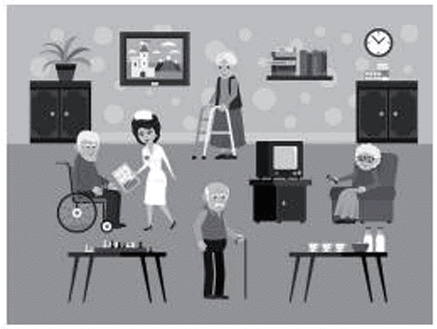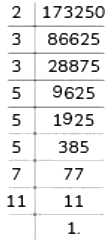Case Based Questions: Real Numbers | Mathematics (Maths) Class 10 PDF Download
Q1: Read the source below and answer the questions that follow:
Old age homes mean for senior citizens who are unable to stay with their families or destitute. These old age homes have special medical facilities for senior citizens such as mobile health care systems, ambulances, nurses and provision of well balanced meals.
 Himanshu, Gaurav and Gagan start preparing greeting cards for each person of an old age home on new year. In order to complete one card, they take 10, 16 and 20 min respectively.
Himanshu, Gaurav and Gagan start preparing greeting cards for each person of an old age home on new year. In order to complete one card, they take 10, 16 and 20 min respectively. i. Co-prime numbers are those numbers which do not have any common factor other than 1. Is this statement true?
ii. Find the sum of the powers of all different prime factors of the numbers 10, 16 and 20.
iii. If all of them started together, then what time will they start preparing a new card together?
iv. What is the common time to make one card?
Ans:
i. True
ii. By prime factorisation, 10=2¹× 5¹ 16=2x2x2x2=24 20 2x2x5=22x5¹ .. Required sum = sum of the power of 2 + sum of the power of 5 = (1 + 4 + 2) + (1+1)=7+2=9
iii. The required number of minutes after which they start preparing a new card together is the LCM of 10, 16 and 20 min. Now, 10=2x5 16=2x2x2x2 20=2x2x5=22x5 .. LCM (10, 16, 20) = 24 x 51 = 16 x 5 = 80 min So, they will start preparing a new card together after 80 min i.e., 1 h 20 min.
iv. The common time to make one card = HCF of (10, 16, 20) = 2 min
Q2: Read the source below and answer the questions that follow:
In a morning walk, Naveeka, Arjun and Vedant step off together, their steps measuring 240 cm, 90 cm, 120 cm respectively. They want to go for a juice shop for a health issue, which is situated near by them.
 i. Factor tree is a chain of factors, which is represented in the form of a tree. Is this statement true?
i. Factor tree is a chain of factors, which is represented in the form of a tree. Is this statement true? ii. Find the sum of the powers of all common prime factors of the numbers 240, 90 and 120.
iii. Find the minimum distance of shop from where they start to walk together, so that one can cover the distance in complete steps.
iv. Find the number of common steps covered by all of them to reach the juice shop.
Ans:
i. True
ii. By prime factorisation, 240=2x2x2x2x3x5=24 x 31 x 5¹ 90=2×3×3×5=2¹×32x5¹ 120=2×2×3×2×5=23×3¹×5¹ :. Required sum = sum of the power of 2+ sum of the power of 3+ sum of the power of 5=1+1+1=3.
iii. Minimum required distance to reach the juice shop = LCM (240, 90, 120) 240 = 2x2x2x2x3x5=24x3x5 90 = 2×3×3×5=2x32x5 and 120 = 2×2×2×3×5=23x3x5 Now, LCM=24x32x5=16x9 × 5=720 Hence, required minimum distance is 720 cm.
iv. The number of common steps covered by all of them HCF (240, 90, 120) = 2 x 3 x 5 =30
Q3: Read the source below and answer the questions that follow:
Teaching Mathematics through activities is a powerful approach that enhances students' understanding and engagement. Keeping this in mind, Ms. Mukta planned a prime number game for class 5 students. She announced the number 2 in her class and asked the first student to multiply it by a prime number and then pass it to the second student. The second student also multiplied it by a prime number and passed it to the third student. In this way by multiplying by a prime number, the last student got 173250.
Now, Mukta asked some questions as given below to the students:
i. What is the least prime number used by students?
ii. How many students are in the class?
iii. What is the highest prime number used by students?
iv. Which prime number has been used maximum times?
Ans:
i. 
So least prime no. used by students = 3(because 2 is announced by the teacher, so the least number used by the students is 3)
ii. As the last student got 173250 = 2 × 3 × 3 × 5 × 5 × 5 × 7 × 11
there are 7 factors other than 2, which is announced by teacher. So, Number of student = 7
iii. Highest prime number used by student = 11
iv. Prime number 5 is used maximum times i.e., 3 times.
Q4: Read the source below and answer the questions that follow:
Ms. Asha planned a prime factorization activity for her Class 10 students. She announced the number 3 in her class and asked the first student to multiply it by a prime number and pass it to the next student. Each student multiplied the result by a prime number and passed it further. The last student ended up with the number 231000.
Now, Ms. Asha asked the following questions:
i. What is the least prime number used by students?
ii. How many students are in the class?
iii. What is the highest prime number used by students?
iv. Which prime number has been used maximum times?
Ans:
i. The least prime number used is 2.
ii. The total number of students is 9 (since there are 9 prime factors).
iii. The highest prime number used is 11.
iv. The prime number used the maximum times is 2 and 5 (each used 3 times).
|
127 videos|685 docs|84 tests
|
FAQs on Case Based Questions: Real Numbers - Mathematics (Maths) Class 10
| 1. What are real numbers and how are they classified? |  |
| 2. How do you compare real numbers? |  |
| 3. What operations can be performed on real numbers? |  |
| 4. What are the properties of real numbers? |  |
| 5. How are real numbers used in everyday life? |  |

















